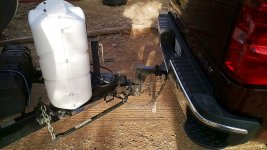Folks,
I have a WD2650BH and I'm going to be dry camping for 10 days. I want to put in a two battery - parallel system, but my head is spinning from reading articles about batteries.
I would like to stay with 12v. I don't want to spend a ton of money and I'm not quite sure what to get.
I currently have an Exide 24MDPST that I would be replacing with this 2 battery solution. (I'd like to stay around the same size to ensure I have room on the tongue for two batteries.)
Do I go with Deep Cycle? Do I go AGM? What brand/model do you fine people recommend?
Thanks in advance and happy camping!
I have a WD2650BH and I'm going to be dry camping for 10 days. I want to put in a two battery - parallel system, but my head is spinning from reading articles about batteries.
I would like to stay with 12v. I don't want to spend a ton of money and I'm not quite sure what to get.
I currently have an Exide 24MDPST that I would be replacing with this 2 battery solution. (I'd like to stay around the same size to ensure I have room on the tongue for two batteries.)
Do I go with Deep Cycle? Do I go AGM? What brand/model do you fine people recommend?
Thanks in advance and happy camping!

